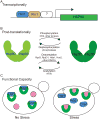The Hsp90 Chaperone Network Modulates Candida Virulence Traits
- PMID: 28549824
- PMCID: PMC5610082
- DOI: 10.1016/j.tim.2017.05.003
The Hsp90 Chaperone Network Modulates Candida Virulence Traits
Abstract
Hsp90 is a conserved molecular chaperone that facilitates the folding and function of client proteins. Hsp90 function is dynamically regulated by interactions with co-chaperones and by post-translational modifications. In the fungal pathogen Candida albicans, Hsp90 enables drug resistance and virulence by stabilizing diverse signal transducers. Here, we review studies that have unveiled regulators of Hsp90 function, as well as downstream effectors that govern the key virulence traits of morphogenesis and drug resistance. We highlight recent work mapping the Hsp90 genetic network in C. albicans under diverse environmental conditions, and how these interactions provide insight into circuitry important for drug resistance, morphogenesis, and virulence. Ultimately, elucidating the Hsp90 chaperone network will aid in the development of therapeutics to treat fungal disease.
Keywords: Candida albicans; Hsp90; development; drug resistance; stress response; virulence.
Copyright © 2017 Elsevier Ltd. All rights reserved.
Figures


References
Publication types
MeSH terms
Substances
Grants and funding
LinkOut - more resources
Full Text Sources
Other Literature Sources

